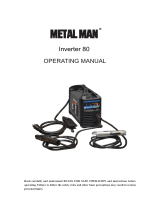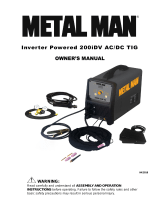
Please read and save these instructions. Read through this owner’s manual carefully before
using product. Protect yourself and others by observing all safety information, warnings, and
cautions. Failure to comply with instructions could result in personal injury and/or damage to
product or property. Please retain instructions for future reference
1
Operating Instructions Air Cooled TIG Torch
1. General Safety Information
1.1 Your Welding Environment
-Keep the environment you will be welding in free from flammable materials.
-Always keep a fire extinguisher accessible to your welding environment.
-Always have a qualified person install and operate this equipment.
-Make sure the area is clean, dry and ventilated. Do not operate the welder in
humid, wet or poorly ventilated areas.
-Always have your welder maintained by a qualified technician in accordance
with local, state and national codes.
-Always be aware of your work environment. Be sure to keep other people,
especially children, away from you while welding.
-Keep harmful arc rays shielded from the view of others.
-Mount the welder on a secure bench or cart that will keep the welder secure
prevent it from tipping over or falling.
1.2 Your Welder’s Condition
-Check all cables, power cord and TIG Torch to be sure the insulation is not
damaged. Always replace or repair damaged components before using the
welder.
-Check all components to ensure they are clean and in good operating condition
before use.
1.3 Use of Your Welder
Do not operate the welder if the welding cables, electrode, TIG torch is wet. Do
not immerse them in water. These components and the welder must be
completely dry before attempting to use them.
-Follow the instructions in this manual.
-Keep welder in the off position when not in use.
-Connect ground lead as close to the area being welded as possible to ensure a
good ground.
-Do not allow any body part to come in contact with the TIG torch if you are in
contact with the material being welded, ground or electrode from another welder.
-Do not weld if you are in an awkward position. Always have a secure stance
while welding to prevent accidents. Wear a safety harness if working above
ground.
-Do not drape cables over or around your body.
-Wear a full coverage helmet with appropriate shade (see ANSI Z87.1 safety
standard) and safety glasses while welding.

2
Air Cooled TIG Torch Operating Instructions
-Wear proper gloves and protective clothing to prevent your skin from being
exposed to hot metals, UV and IR rays.
-Do not overuse or overheat your welder. Allow proper cooling time between duty
cycles.
-Keep hands and fingers away from moving parts.
-Do not point TIG torch at any body part of yourself or anyone else.
-Always use this welder in the rated duty cycle to prevent excessive heat and
failure.
1.4 Specific Areas of Danger, Caution or Warning
Electrical Shock
Electric arc welders can produce a shock that can cause injury or
death. Touching electrically live parts can cause fatal shocks and
severe burns. While welding, all metal components connected to
the TIG torch are electrically hot. Poor ground connections are a hazard, so
secure the ground lead before welding.
-Wear dry protective apparel: coat, shirt, gloves and insulated footwear.
-Insulate yourself from the work piece. Avoid contacting the work piece or ground.
- Do not attempt to repair or maintain the welder while the power is on.
-Inspect all cables and cords for any exposed wire and replace immediately.
-Use only recommended replacement cables and cords.
-Always attach ground clamp to the work piece or work table as close to the weld
area as possible.
-Do not touch the TIG Torch and the ground or grounded work piece at the same
time.
-Do not use a welder to thaw frozen pipes.
Fumes and Gases
-Fumes emitted from the welding process displace clean air and can
result in injury or death.
-Do not breathe in fumes emitted by the welding process. Make sure
the air you breath is clean and safe.
-Work only in a well-ventilated area or use a ventilation device to remove welding
fumes from the environment where you will be working.
-Do not weld on coated materials (galvanized, cadmium plated or containing zinc,
mercury or barium). They will emit harmful fumes that are dangerous to breathe.
If necessary use a ventilator, respirator with air supply or remove the coating
from the material in the weld area.
-The fumes emitted from some metals when heated are extremely toxic. Refer to
the material safety data sheet for the manufacturer’s instructions.
-Do not weld near materials that will emit toxic fumes when heated. Vapors from
cleaners, sprays and degreasers can be highly toxic when heated.

3
Air Cooled TIG Torch Operating Instructions
UV and IR Arc Rays
The welding arc produces ultraviolet (UV) and infrared (IR) rays that
can cause injury to your eyes and skin. Do not look at the welding
arc without proper eye protection.
-Always use a helmet that covers your full face from the neck to top of head and
to the back of each ear.
-Use a lens that meets ANSI standards and safety glasses. For welders under
200 Amps output, use a shade 10 lens; for above 200 Amps, use a shade 12.
Refer to the ANSI standard Z87.1 for more information.
-Cover all bare skin areas exposed to the arc with protective clothing and shoes.
Flame-retardant cloth or leather shirts, coats, pants or coveralls are available for
protection.
-Use screens or other barriers to protect other people from the arc rays emitted
from your welding.
-Warn people in your welding area when you are going to strike an arc so they
can protect themselves.
Fire Hazards
Do not weld on containers or pipes that contain or have had
flammable, gaseous or liquid combustibles in them. Welding creates
sparks and heat that can ignite flammable and explosive materials.
-Do not operate any electric arc welder in areas where flammable or explosive
materials are present.
-Remove all flammable materials within 35 feet of the welding arc. If removal is
not possible, tightly cover them with fireproof covers.
-Take precautions to ensure that flying sparks do not cause fires or explosions in
hidden areas, cracks or areas you cannot see.
-Keep a fire extinguisher close in the case of fire.
-Wear garments that are oil-free with no pockets or cuffs that will collect sparks.
-Do not have on your person any items that are combustible, such as lighters or
matches.
-Keep work lead connected as close to the weld area as possible to prevent any
unknown, unintended paths of electrical current from causing electrical shock
and fire hazards.
-To prevent any unintended arcs, do not place TIG torch on grounded work
surface.
Hot Materials
Welded materials are hot and can cause severe burns if handled
improperly.
-Do not touch welded materials with bare hands.
-Do not touch TIG torch or electrode after welding until it has had time to cool
down.

4
Air Cooled TIG Torch Operating Instructions
Sparks/Flying Debris
Welding creates hot sparks that can cause injury. Chipping slag off
welds creates flying debris.
-Wear protective apparel at all times: ANSI-approved safety glasses
or shield, welder’s hat and ear plugs to keep sparks out of ears and hair.
Electromagnetic Field
-Electromagnetic fields can interfere with various electrical and
electronic devices such as pacemakers.
-Consult your doctor before using any electric arc welder or cutting
device
-Keep people with pacemakers away from your welding area when welding.
-Do not wrap cable around your body while welding.
-Wrap TIG torch and ground cable together whenever possible.
-Keep TIG torch and ground cables on the same side of your body.
Shielding Gas Cylinders Can Explode
High pressure cylinders can explode if damaged, so treat them
carefully
-Never expose cylinders to high heat, sparks, open flames,
mechanical shocks or arcs
-Do not touch cylinder with TIG torch
-Do not weld on the cylinder.
-Always secure cylinder upright to a cart or stationary object.
-Keep cylinders away from welding or electrical circuits.
-Use the proper regulators, gas hose and fittings for the specific application.
-Do not look into the valve when opening it.
-Use protective cylinder cap whenever possible.
1.5 Proper Care, Maintenance and Repair
-Always have power disconnected when working on internal components.
- Do not touch or handle PC board without being properly grounded with a wrist
strap. Put PC board in static proof bag to move or ship.
-Do not put hands or fingers near moving parts such as the cooling fan

5
Air Cooled TIG Torch Operating Instructions
EZ Feed Spool Gun
2. Description
The Air Cooled TIG torch is
designed to operate with the
MIG/Stick 140, MIG/Stick 200 or
Hybrid MIG/Stick 200 welder for
DC lift start TIG welding on steels
or stainless steels. This torch may
also be used on other TIG
welding units with twist lock style
weld terminals.
The Air Cooled TIG torch is rated
at 150A at 35% duty cycle. This
torch is ideal for light fabrication,
welding repair and maintenance
operations.
3. Specifications and Dimension
DESCRIPTION
SPECIFICATIONS
Amperage 150A
Cooling Method Air-Cooled
Duty cycle 35%
Suggested Tungsten Sizes .020 in. to 1/16 in.
Cable Length 9 ft.
Net Weight 3 lbs.

6
Air Cooled TIG Torch Operating Instructions
4. Assembly & Set-Up
1.
Remove Ground Cable and install in the electrode holder
connection. This sets up the TIG torch for DC Electrode
Negative which is needed for DC TIG welding of steels
and stainless steels.
2.
Secure the ground clamp to the surface you are welding.
3.
Connect your regulator and gas hose to the bottle of
shielding gas. Typically 100% argon is used for most TIG
applications. Connect the TIG torch gas connection to
the regulator.
4.
Connect the TIG torch to the Ground Cable connection.
This sets up the TIG torch for DC Electrode Negative
which is needed for DC TIG welding of steels and
stainless steels.
5.
Flip the process selector switch into the stick mode. This
puts the machine into the constant current mode needed
for TIG welding.
Be aware that the TIG torch is now electrically hot. Keep
TIG torch away from the grounded work surface until
ready to weld.
6.
Set Amperage on the front of the welder
7.
Turn on the input power switch on your welder.
Be aware that the TIG torch is now electrically hot. Keep
TIG torch away from the grounded work surface until
ready to weld.

7
Air Cooled TIG Torch Operating Instructions
8.
Turn the TIG Torch gas valve clockwise to start the flow
of shielding gas. After welding, turn the TIG torch gas
valve counter-clockwise to turn off the flow of shielding
gas.
9.
Touch tungsten to work piece and lift away to start arc.

8
Air Cooled TIG Torch Operating Instructions
5. Spare Parts List
Reference
number
Description Qty
1
Plastic cap 1
2
Long cap 1
3
Short cap 1
4
White cap 1
5
Nozzle 4# 6.5
1
6
Nozzle 5# 8.0
1
7
Switch 1
8
Nozzle 6# 9.5
1
9
Tungsten needle 1.6
1
10
Tungsten needle 1.0 2.4
Per 1
11
Diversion
3.2
1
12
Diversion 2.4
1

9
Air Cooled TIG Torch Operating Instructions
13
Screw 1
14
Cable 16mm2
1
15
Handle cover 1
16
Copper 1
17
Cable cover 1
18
Gas connector 1
19
Gas hose 6
1
20
Clip SK 10-25
1

10
Air Cooled TIG Torch Operating Instructions
Other Safety and Standards Information
This manual is designed to inform the operator of safety and general use of this
model only. For further information about welding safety refer to the following
standards and comply with them where applicable.
• ANSI Standard Z49.1 — SAFETY IN
WELDING AND CUTTING obtainable
from: American Welding Society 550 NW
Le Jeune Road, Miami, FL 33126
Tel. (800) 443-9353 Fax (305) 443-7559
www.amweld.org or www.aws.org
• ANSI Standard Z87.1 — SAFE PRACTICE
FOR OCCUPATION AND EDUCATIONAL
EYE AND FACE PROTECTION
Obtainable from: American National
Standards Institute (ANSI) 11 West 42nd
St. New York, NY 10036
Tel. (212) 642-4900 Fax (212) 398-0023 www.ansi.org
• NFPA Standard 51B — CUTTING AND
WELDING PROCESS obtainable from:
National Fire Protection Association,
1 Batterymarch Park, P.O. Box 9101
Quincy, MA 02269-9101
Tel. (617) 770-3000 Fax (617) 770-0700 www.nfpa.org
• OSHA Standard 29 CFR, Part 1910,
Subpart Q. —WELDING, CUTTING AND
BRAZING obtainable from your state
OSHA office or from: U. S. Dept. of Labor
OSHA, Office of Public Affairs Room
N3647, 200 Constitution Ave. NW
Washington, DC 20210 www.osha.gov
• CSA Standard W117.2 — Code for
SAFETY IN WELDING AND CUTTING
Obtainable from: Canadian Standards
Association, 178 Rexdale Blvd.,
Etobicoke, Ontario M9W 1R3
www.csa.ca
• American Welding Society Standard A6.0
—WELDING AND CUTTING CONTAINERS
WHICH HAVE HELD COMBUSTIBLES
Obtainable from: American
Welding Society, 550 NW Le Jeune Road
Miami, FL 33126
Tel. (800) 443-9353
Fax (305) 443-7559
www.amweld.org or www.aws.org
-
 1
1
-
 2
2
-
 3
3
-
 4
4
-
 5
5
-
 6
6
-
 7
7
-
 8
8
-
 9
9
-
 10
10
Ask a question and I''ll find the answer in the document
Finding information in a document is now easier with AI
Related papers
Other documents
-
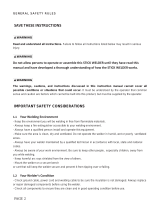 HIT Welding 802054 User manual
HIT Welding 802054 User manual
-
Craftsman 196300840 Owner's manual
-
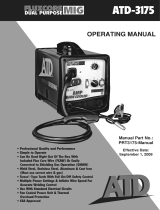 ATD Tools ATD-3175 User manual
ATD Tools ATD-3175 User manual
-
Craftsman 196.205690 User manual
-
Clarke Fluxcore/MIG 135sg WE6441 Operating instructions
-
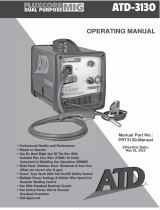 ATD Tools ATD-3175 Specification
ATD Tools ATD-3175 Specification
-
Forney 298 100 ST Easy Weld User manual
-
Forney Easy Weld 140 MP User manual
-
Craftsman 196205680 Owner's manual
-
Miller GOLD SEAL 160i CE Owner's manual











